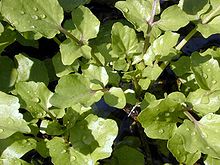Nasturtium (genus)
| Nasturtium | |
|---|---|
 |
|
| Nasturtium microphyllum, a watercress, in Hawai'i | |
| Scientific classification | |
| Kingdom: | Plantae |
| (unranked): | Angiosperms |
| (unranked): | Eudicots |
| (unranked): | Rosids |
| Order: | Brassicales |
| Family: | Brassicaceae |
| Genus: |
Nasturtium W.T. Aiton |
| Species | |
|
|
Nasturtium /nəˈstɜːr.ʃəm/ is a genus of seven plant species in the family Brassicaceae (cabbage family), best known for the edible watercresses Nasturtium microphyllum (Rorippa microphylla) and Nasturtium officinale (R. nasturtium-aquaticum). Nasturtium was previously synonymised with Rorippa, but molecular evidence supports its maintenance as a distinct genus more closely related to Cardamine than to Rorippa sensu stricto (Al-Shehbaz & Price, 1998; Al-Shehbaz, Beilstein & Kellogg, 2006). Yellowcress is a common name for plants in this genus.
These plants are related to garden cress and mustard, noteworthy for a peppery, tangy (pungent) flavor. The name Nasturtium comes from the Latin nasus tortus, meaning "twisted nose", in reference to the effect on the nasal passages of eating the plants. Nasturtium foliage is used as food by the caterpillars of certain Lepidoptera, including Orthonama obstipata (The Gem).
One species, Nasturtium gambelii, is a federally listed endangered species in the United States.
The genus Nasturtium should not be confused with the flowering garden annual commonly known as nasturtium (Tropaeolum majus). Though not related, the leaves of the garden nasturtium also have a peppery taste.
...
Wikipedia
